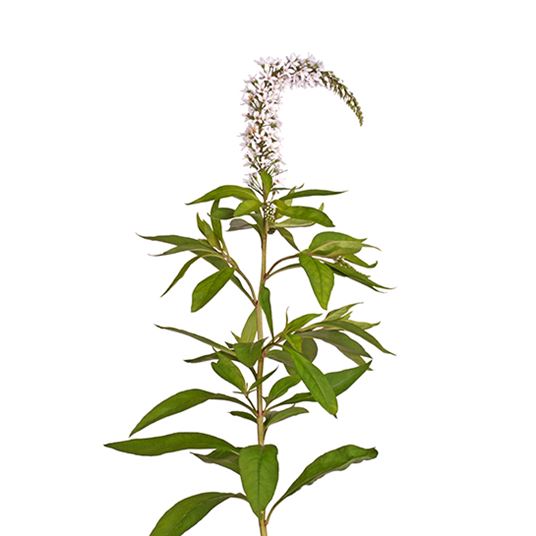
LYSIMACHIA
Lysimachia clethroides
ly-si-MAH-kee-a kleth-ROY-deez
Description
Savage beasts are no match for this pleasing perennial! More commonly known as gooseneck loosestrife (or loosestrife for short), Lysimachia is a perennial plant native to Japan, China and Indonesia. According to Macedonian legends dating back over 3,000 years, King Lysimachus of Thrace used Lysimachia to calm a mad ox. The plant’s calming properties may also explain the common name loosestrife, which is derived from the Greek word that means to end strife. Its flowering stems are commonly used as garden plants, but have also become popular cut flowers throughout the recent decades.
The plant’s robust, erect stems typically grow 60–92 cm tall, feature medium green leaves and spread aggressively through underground rhizomes to form large colonies. In fact, some members of the genus grow so successfully that in some areas of the U.S., they have been declared as a potential invasive species. Lysimachia stems are topped with numerous, star-shaped florets (usually white or yellow in color) that emerge from tapered racemes arching above the foliage like shooting stars. These floral spikes typically range from 30–45 cm in length. So, as its common name suggests, the plant’s curved stems resemble a goose’s neck. Although all varieties of Lysimachia bear beautiful flowers, these plants are also cultivated for their attractive foliage. For example, 'Alexander' offers showstopping, medium green leaves that are rimmed in a cream hue.
The genus is made up of about 190 species of herbaceous and evergreen perennials, mostly growing in damp grasslands or near bodies of water in subtropical regions. Compared to other perennial plants, Lysimachia does not contain a significant number of cultivars or hybrids. The common name loosestrife is also applied to plants in two different genera of two different families: Lysimachia (ex. gooseneck loosestrife) is in the Primulaceae family and Lythrum (ex. purple loosestrife) is in the Lythraceae family.
Today, Lysimachia is used as a cut flower and garden ornamental. Their attractive stems and soothing colors make for an elegant accent in fresh flower designs, but can also be hung to dry to enhance dried floral arrangements.
Colors: White, yellow
Special Care
Select straight, sturdy stems with long racemes and about one-half of their florets open. All closed buds on the spike should show good color. Foliage should also be unmarked and in good condition.
When processing, strip foliage that falls below the water line. Recut the stems about 2.5 cm at an angle (45-degrees) and hydrate them in water mixed with a commercial floral preservative (with an anti-ethylene agent) for at least two hours before storage or use in floral work. Although not required, stems can be recut under running water or in a bowl of clean water. Cutting under water may reduce the risk of air pockets forming at the stems’ base and allows the flowers to absorb water right away.
Stems can be stored at 37–41ºF (2.8–5ºC) with a relative humidity of 90–95%. Avoid contact with ethylene, as Lysimachia is sensitive to the gas.
Fun Facts:
The name Lysimachia references King Lysimachus of Thrace. Thousand-year-old legends from Macedonia say that he used the plant to calm a wild ox. The plant’s calming properties may also explain the common name loosestrife, which is derived from the Greek word meaning to end strife. For those seeking a plant that evokes a sense of calm and tranquility, Lysimachia should be the flower choice!
The common name loosestrife is typically used to refer to plants in two different genera of two different families: Lysimachia (ex. gooseneck loosestrife) in the Primulaceae family and Lythrum (ex. purple loosestrife) in the Lythraceae family.
The genus consists of about 190 species of herbaceous perennials and shrubs, typically growing in damp environments in subtropical regions. Some species, like Lysimachia clethroides, can grow to 122 cm in height. Their flowers come in different shapes, and are usually white or yellow in color, but may also come in purple or pink.
In ideal growing conditions, Lysimachia may spread aggressively and form large colonies. In fact, in some areas of the U.S., purple loosestrife grows so successfully that it has been declared as a potential invasive species to wetland regions.
Aside from its regular ornamental uses, Lysimachia has been featured in herbal and traditional Chinese medicines. Different species offer different medicinal applications; it can be used to treat urinary disorders, eye problems, jaundice and some skin infections, among other medical ailments.
Lysimachia clethroides, a popular species of the genus in floral design work, is commonly known as gooseneck loosestrife. It features tiny, star-shaped flowers tightly condensed into tapered racemes (typically 30–45 cm in length) that arch above the foliage. This structural aspect mimics a goose’s neck—hence the name, gooseneck.
Lysimachia is closely related to Cyclamen and shooting star plants.
Common Name
loosestrife, gooseneck loosestrife, creeping Jenny, moneywort, willow herb, purple willow herb, long purples
Botanical Name
Lysimachia clethroides
Pronunciation
ly-si-MAH-kee-a kleth-ROY-deez
Origin

Seasonal availability
Vase Life
5 - 10 days
Fragrant
No
Ethylene
Sensitive
Yes
Dryable
Yes